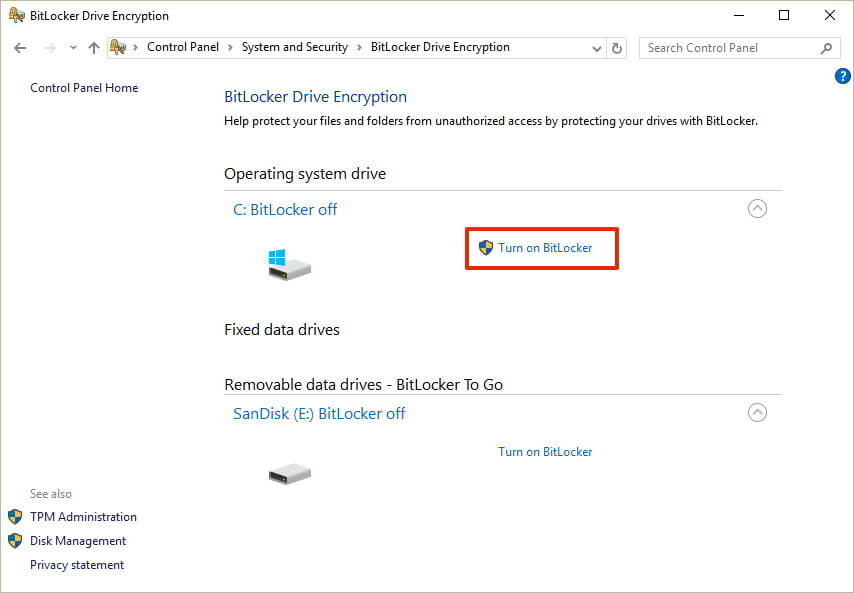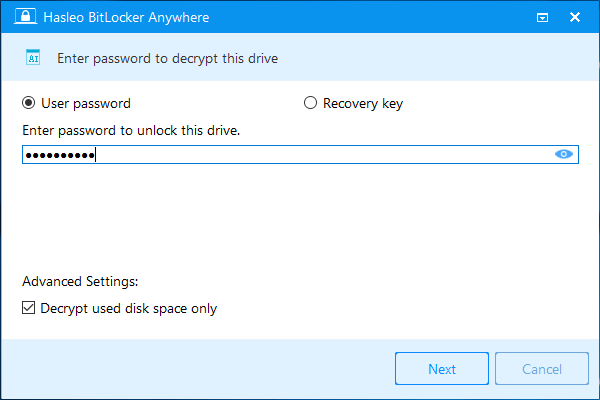Encryption For Windows 10 Home
- Encryption Options For Windows 10 Home
- Device Encryption For Windows 10 Home
- How To Enable Bitlocker Windows 10
Nov 30, 2018 As the best full disk encryption software for Windows 10 Home, you can not only use it to encrypt the disk, but also use it to decrypt the disk, change encryption password, export BitLocker Recovery Key & Startup Key, lock & unlock BitLocker Encrypted Drive.
Sep 08, 2018 Device encryption is a basic capability on PC’s running Windows 10, including those running Windows 10 Home. On these PC’s device encryption is automatically enabled when the following requirements are met. BitLocker drive encryption is a pretty advanced and useful feature of Windows and with the latest Windows 10, it’s better than ever. The fact that you can encrypt the contents of entire volumes makes it highly usable, especially for those who have to carry large volumes of sensitive digital information from one system to another. Jul 23, 2019 To enable device encryption on your Windows 10 Home laptop or desktop computer, use these steps: Open Settings. Click on Update & Security. Click on Device encryption. Just because you have antivirus software installed on your PC doesn't mean a zero-day Trojan can't steal your personal data. The best encryption software keeps you safe from malware (and the NSA). Windows 10 is same as Windows 8 and Windows 8.1, Bitlocker drive encryption is still not available on Windows 10 Home. Although Bitlocker drive encryption feature is missing in Control Panel of Windows 10 Home, but there are three options to enable/install Bitlocker on Windows 10 Home edition. May 21, 2019 Windows 10 has a neat feature called Device Encryption. When enabled, Device Encryption encrypts the data in all fixed drives (like your HDD) with 128-bit AES encryption and protects your system from any unauthorized access. For instance, an attacker cannot connect your hard disk to another system to access or modify the data.
A reader recently asked us if the Device encryption feature present in Windows 10 Home edition as well. In this guide, we will discuss if the Device encryption is available in Windows 10 Home, how to check if your computer supports the Device encryption feature and how to turn on Device encryption.
Device encryption feature help protect data on your Windows 10 computer. If you turn on device encryption, only authorized people can access the data on your computer. It stops malicious users from accessing system files and accessing your drive by connecting it a different computer. The Device encryption feature protects the drive where Windows 10 is installed and other fixed drives on the computer using AES 128-bit encryption.
Is Device encryption available on Windows 10 Home edition?
The Device encryption feature is present in all editions of Windows 10 (version 1511 and later), including the Home edition. In simple words, you can encrypt your files even if you are on Windows 10 Home edition.
However, the Device encryption feature is not available on all computers as many computers don’t meet the minimum hardware requirements for the same (scroll down the page to see how to check if your PC supports Device encryption). Here are the hardware requirements for Device encryption:
* TPM enabled computer
* UEFI enabled computer
* Computer must support connected standby
Besides the stringent hardware requirements, you must be using a Microsoft account to sign in to Windows 10 in order to turn on and use the Device encryption. When you sign in with a Microsoft account on a PC meeting hardware requirements, Device encryption is automatically enabled. You can check the same by navigating to Settings > Update & Security > Device encryption.
Are BitLocker encryption and Device encryption same?
Well, BitLocker encryption and Device encryption are two encryption features available in Windows 10. While the BitLocker is present only in Pro and Enterprise editions, the Device encryption is available in all editions provided that your computer supports the feature. The BitLocker is an advanced and more secure encryption when compared to Device encryption.
Check if your PC supports device encryption
Note that your PC might support BitLocker encryption feature even if your PC doesn’t support the Device encryption feature. However, BitLocker encryption exist in Professional and Enterprise editions of Windows 10 only. So, Home users cannot use BitLocker encryption.
Step 1: Type System Information in the taskbar search field, right-click on System Information entry and then click Run as administrator option.
Click on the Yes button when you get the User Account Control screen.
Step 2: Select System Summery in the left-pane. On the right-side, look for Device Encryption Support entry.
Step 3: If the Device Encryption Support value says Meets prerequisites, then your computer supports Device Encryption. If not, your PC doesn’t support Device encryption. As you can see the picture below, my PC doesn’t support Device encryption.
Turn on or off Device encryption
Step 1: Navigate to the Settings app > Update & Security, and check if there is Device encryption page. If your computer supports Device encryption, Windows 10 will list the Device encryption page under Settings > Update & Security.
Step 2: You can turn on or off the Device encryption on the same page.
Hope you find this guide helpful!
I have Windows 10 Home edition, not Professional edition. Is there any way to install Bitlocker on Windows 10 Home, or do I have to upgrade to Windows 10 Professional?
Windows 10 is same as Windows 8 and Windows 8.1, Bitlocker drive encryption is still not available on Windows 10 Home.
Although Bitlocker drive encryption feature is missing in Control Panel of Windows 10 Home, but there are three options to enable/install Bitlocker on Windows 10 Home edition.
Option 1: Encrypt the drive on another Windows 10 Professional computer
Find another Windows 10 Professional computer, encrypt the drive with Bitlocker and then move the Bitlocker encrypted drive to the Windows 10 Home computer.
Option 2: Upgrade Windows 10 Home to Windows 10 Professional
Although Bitlocker drive encryption feature is missing on Windows 10 Home, but it is available in Windows 10 Professional, but it is not very nice to pay US$99 for Bitlocker drive encryption feature.
Option 3: M3 Bitlocker Loader for Windows
M3 Bitlocker Loader for Windows is a Bitlocker solution which can enable/turn on Bitlocker drive encryption on hard drive or USB flash drive on Windows 10/8/7 home editions.
After encrypting the drive and wanting to open Bitlocker encrypted drive on Mac, please download M3 Bitlocker Loader for Mac.
Step 1: Download and install M3 Bitlocker Loader for Windows on Windows computer.
Step 2: Launch M3 Bitlocker Loader for Windows.
Step 3: Select the drive you want to encrypt.
Step 4: Click Encrypt.
Step 5: Enter the password and then click Next.
Step 6: Save the recovery key and then click Next.
Step 7: Start Bitlocker drive encryption on the specific drive in Windows 10 Home.
How to unlock Bitlocker encrypted drive on Windows 10 Home?
Although Bitlocker drive encryption feature is missing on Windows 10 Home Control Panel, but Windows 10 Home can unlock and write Bitlocker encrypted drive, M3 Bitlocker Loader for Windows also has this function.
Step 1: Right click the Bitlocker encrypted drive in My Computer (This PC) or Disk Management.
Step 2: Select Unlock from the right-click menu.

Step 3: Enter the password to unlock Bitlocker encrypted drive.
If you don't have the password, please click 'More options' -> click 'Enter recovery key'.

Enter the recovery key to unlock Bitlocker encrypted drive.
How to change the Bitlocker password on Windows 10 Home?
Step 1: Type cmd in search, right click cmd.exe from the search results and then choose 'Run as administrator' from the right-click menu.
Encryption Options For Windows 10 Home
Step 2: Type the command: manage-bde -changepassword X: (Replace X with the drive letter of your Bitlocker encrypted drive), and press Enter.
Device Encryption For Windows 10 Home
Step 3: Type the new password when prompted and press Enter.
Step 4: Confirm the new password by typing it again when prompted and press Enter.
Step 5: If your password has been successfully updated, you can now close the command prompt window.
How to turn off Bitlocker drive encryption on Windows 10 Home?
Step 1: Type cmd in search, right click cmd.exe from the search results and then choose 'Run as administrator' from the right-click menu.
Step 2: When Command Prompt opens, enter the command: manage-bde -off X: and press Enter (Replace X with the drive letter of your Bitlocker encrypted drive). After that, Bitlocker drive encryption will be turned off on the specific drive and the data is not protected by Bitlocker any more.
How To Enable Bitlocker Windows 10
Related articles:




